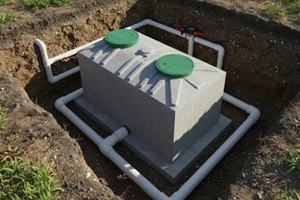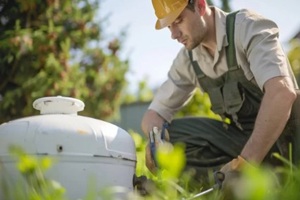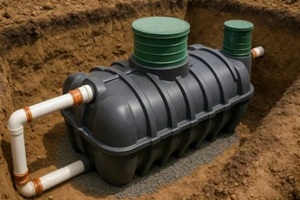
A healthy septic system keeps your water and your home running smoothly. For Maryland homeowners, maintaining a system goes beyond routine pumping; local regulations, special soil conditions, and environmental factors all play a part in keeping everything working as it should.
With more than 420,000 households in the state relying on septic, knowing how to care for your system can save you money, prevent emergencies, and protect the Chesapeake Bay. Read on for practical, Maryland-specific tips that make maintenance simpler and smarter.
How Septic Systems Work
A septic system handles all wastewater that leaves the home, treating and dispersing it safely underground.
Within a conventional system, water enters the underground tank, allowing solids to sink while liquids remain above. The clarified liquid, or effluent, moves to the drainfield, where natural soil microbes treat it further before it returns to the groundwater.
Some systems include pumps or advanced treatment units, adding electrical and mechanical components that need regular service. Knowing which type of system is on the property is the first step to proper care and maintenance.
Setting a Smart Maintenance Schedule
Keeping up with routine maintenance helps make sure that your septic system operates efficiently and saves you from high repair bills.
According to the U.S. Environmental Protection Agency (EPA), conventional systems should be inspected every one to three years and pumped every three to five years, based on factors like tank size, water usage, and household occupancy. Advanced systems with pumps or nitrogen-reducing treatment units usually require annual inspections and more frequent attention.
Maryland counties may have additional guidelines. For example, some counties recommend pumping every three years, while Queen Anne’s County requires a pump-out at least every five years by ordinance. Homeowners should keep records of inspections and pump-outs and mark important dates on the calendar.
Effluent filters, found in many modern tanks, should be cleaned annually. Adding a riser to bring the tank lid up to ground level makes service visits easier, faster, and less expensive.
Mapping and Recording System Details
A simple site map of the septic system helps during maintenance and emergencies. Mark the location of the tank, lids, drainfield, and any pumps or advanced units.
The University of Maryland Extension (UME) provides printable record folders that help homeowners track service intervals and keep diagrams on file for easy reference.
Protecting the Drainfield

The drainfield is one of the most important parts of the system, and protecting it from damage is essential to keep the system operating as it should.
Heavy weight from vehicles, sheds, or patios can crush pipes and compact soil, reducing its ability to filter wastewater. Downspouts, sump pumps, and irrigation systems should be directed away from the area so the soil stays dry enough to treat effluent effectively.
Planting shallow-rooted groundcover or grass above the field is safe; deeper roots can damage pipes and disrupt drainage. Simple landscaping choices can prevent costly repairs and keep the drainfield functioning as designed.
Water Use and Household Habits
The way water is used in the home can directly impact the health of the septic system. Spreading out laundry loads over the week helps prevent sudden surges that can push solids into the drainfield. High-efficiency toilets, faucets, and showerheads reduce the amount of water entering the system, extending its life.
Being cautious about what you send through sinks and toilets goes a long way toward preventing costly problems later on. Limit toilet use to the three Ps only: pee, poop, and paper. Disposing of wipes, grease, solvents, paint, or medications through sinks or toilets can lead to clogs, chemical imbalances, or damage to the drainfield.
Garbage disposals increase solids in the tank, and Maryland UME advises against using them with septic systems to prevent early system failure.
After Storms, Flooding, or Power Outages
Heavy rain and flooding caused by Maryland weather can negatively affect septic performance. When the yard is flooded or the ground is saturated, pumping the tank should wait until the soil drains, as an empty, lightweight tank in saturated soil can float and break pipes.
During these times, reduce water use. Once conditions improve, have the tank and pump chamber inspected for silt or damage. For systems with pumps, power outages require extra attention. Reduce water use until power returns and the pump resumes operation.
If an alarm sounds when power is restored, silence it and call a service provider to inspect the pump function and water levels. For safety reasons, avoid opening electrical panels or accessing the tank on your own.
Well and Septic Care Together
Homes with both a private well and a septic system need to consider how the two systems interact.
The state generally requires a separation distance of at least 100 feet between septic components and potable wells in unconfined aquifers and at least 50 feet in confined aquifers; however, site-specific regulations may vary. Always refer to the property’s approved site plan to verify distances.
Annual water testing is strongly recommended. The EPA and Maryland health officials recommend annual testing for pH, nitrates, total coliform bacteria, and total dissolved solids. Additional testing is advisable if there is flooding near the drainfield or if the water exhibits changes in taste, odor, or color.
Keep Your Septic System Flowing Smoothly

Regular maintenance and informed care keep your septic system reliable, your property protected, and your water safe.
With over 34 years of experience serving Maryland, Virginia, and West Virginia, the team at Tri-County Pump Service understands how to handle everything from routine inspections and pumping to advanced system maintenance and water treatment solutions.
If you are ready to schedule your next inspection, need expert guidance on your system, or have questions about well and water treatment services, we are here to help. Contact us by calling 1-(301)-783-0038, submitting a request via our website, or utilizing our online contact form to initiate the process.



